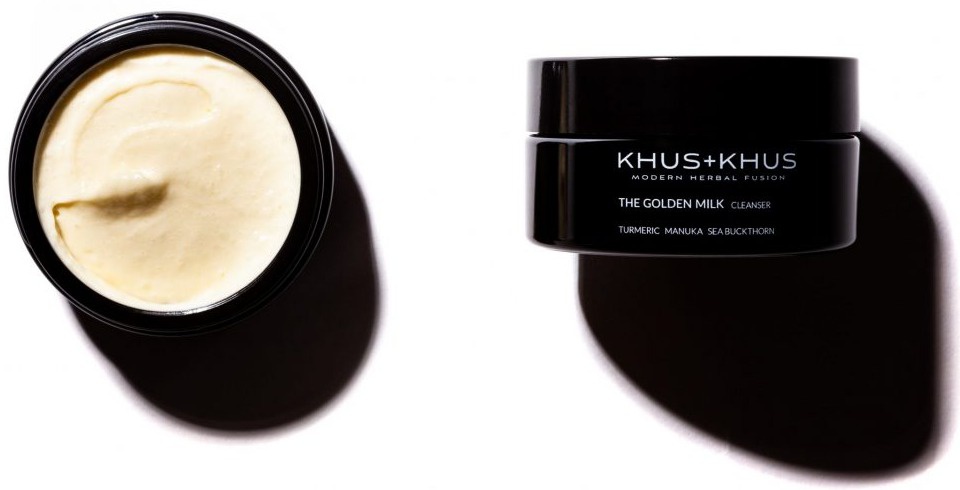
Golden Milk Cleanser
Highlights
Key Ingredients
Other Ingredients
Skim through
| Ingredient name | what-it-does | irr., com. | ID-Rating |
|---|---|---|---|
| Caprylic/Capric Triglyceride* | emollient | ||
| Sodium Methyl Cocoyl Taurate | surfactant/cleansing | ||
| Citric Acid | buffering | ||
| Stearic Acid | emollient, viscosity controlling | 0, 2-3 | |
| Cetyl Alcohol | emollient, viscosity controlling | 2, 2 | |
| Leptospermum Scoparium (Manuka)* | antimicrobial/antibacterial, antioxidant | goodie | |
| Hippophae Rhamnoides (Sea Buckthorn)* | |||
| Curcuma Longa Oil* | perfuming | ||
| Silver Dihydrogen Citrate | preservative |
Khus + khus Golden Milk CleanserIngredients explained
A super common emollient that makes your skin feel nice and smooth. It comes from coconut oil and glycerin, it’s light-textured, clear, odorless and non-greasy. It’s a nice ingredient that just feels good on the skin, is super well tolerated by every skin type and easy to formulate with. No wonder it’s popular.
A mild and non-drying cleanser that gives skin a nice and soft after-feel. It also has great foaming properties, comes from coconuts and it's biodegradable.
Citric acid comes from citrus fruits and is an AHA. If these magic three letters don’t tell you anything, click here and read our detailed description on glycolic acid, the most famous AHA.
So citric acid is an exfoliant, that can - just like other AHAs - gently lift off the dead skin cells of your skin and make it more smooth and fresh.
There is also some research showing that citric acid with regular use (think three months and 20% concentration) can help sun-damaged skin, increase skin thickness and some nice hydrating things called glycosaminoglycans in the skin.
But according to a comparative study done in 1995, citric acid has less skin improving magic properties than glycolic or lactic acid. Probably that’s why citric acid is usually not used as an exfoliant but more as a helper ingredient in small amounts to adjust the pH of a formulation.
A common multi-tasker fatty acid. It makes your skin feel nice and smooth (emollient), gives body to cream type products and helps to stabilize water and oil mixes (aka emulsions).
A so-called fatty (the good, non-drying kind of) alcohol that does all kinds of things in a skincare product: it makes your skin feel smooth and nice (emollient), helps to thicken up products and also helps water and oil to blend (emulsifier). Can be derived from coconut or palm kernel oil.
The essential oil coming from the Manuka tree native to New Zealand. It is distantly related to the Australian Tea Tree Oil, although their chemical composition is very different.
The main antibacterial active in tea tree oil is terpinen-4-ol (40%), while manuka's main actives are so-called cyclic triketones, such as Leptospermone, Iso-leptospermone, and Flavesone (20-30%). Both oils are antibacterial and antifungal but in different ways.
While tea tree oil is a pretty well established anti-acne ingredient, manuka has more of a "might be useful" status for problem skin. Its strong suit is treating fungal infections such as athlete's foot, nail bed infections or foot odor. Other than that, manuka can help to relax muscles (useful for treating muscle and joint pain) and also has some antioxidant activity.


You may also want to take a look at...
| what‑it‑does | emollient |
| what‑it‑does | surfactant/cleansing |
| what‑it‑does | buffering |
| what‑it‑does | emollient | viscosity controlling |
| irritancy, com. | 0, 2-3 |
| what‑it‑does | emollient | viscosity controlling |
| irritancy, com. | 2, 2 |
| what‑it‑does | antimicrobial/antibacterial | antioxidant |
| what‑it‑does | perfuming |
| what‑it‑does | preservative |





